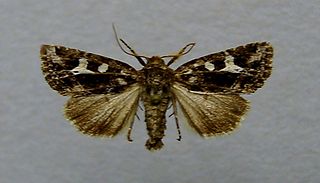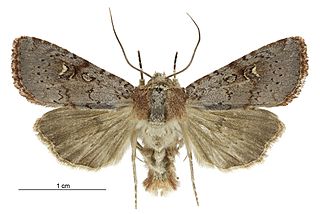Related Research Articles

Caradrina clavipalpis, the pale mottled willow, is a moth of the family Noctuidae. The species was first described by Giovanni Antonio Scopoli in his 1763 Entomologia Carniolica. It is found in the Palearctic realm. It is an introduced species in North America, where it was first reported from Queens in New York City in 1993. In 2009 it was found in Rochester, New York, so it appears to be established and spreading.
Acrapex atriceps is a species of moth of the family Noctuidae first described by George Hampson in 1910. It is found in India.
Acrapex rhabdoneura is a species of moth of the family Noctuidae first described by George Hampson in 1910. It is found in Africa, including Kenya.
Acrapex roseotincta is a species of moth of the family Noctuidae first described by George Hampson in 1910. It is found in Sri Lanka.
Amolita irrorata is a species of moth in the family Erebidae first described by George Hampson in 1910. The species is found in South America, including Paraguay and Brazil. Its wingspan is 26–32 mm.
Amolita perstriata is a species of moth in the family Erebidae first described by George Hampson in 1910. The species is found on the Bahamas. Its wingspan is about 22 mm.
Acylita cara is a species of moth of the family Noctuidae first described by William Schaus in 1894. It is found in Brazil. Its wingspan is about 28 mm.

Celaena haworthii, or Haworth's minor, is a moth of the family Noctuidae. The species was first described by John Curtis in 1829. It is found from the British Isles and France through northern Europe including Scandinavia, east to the Urals and across the Palearctic to Siberia and up to the Pacific Ocean.
Cathayia purpureotincta is a species of snout moth in the genus Cathayia. It was described by George Hampson in 1917 and is known from Borneo.
Scopula ferruginea is a moth of the family Geometridae. It was described by George Hampson in 1893. It is endemic to Sri Lanka.

Ichneutica hartii is a moth of the family Noctuidae. This species is endemic to New Zealand and can be found only in the North Island. I. hartii is similar in appearance to Ichneutica agrorastis but can be distinguished as it tends to be smaller in size and have a more purplish shade to it's fore wings. I. hartii tends to be found inhabiting lowland native forest or forests found in the hilly ranges of the North Island. It is attracted to light and the adults of this moth are on the wing between January and March. Much of its life history is currently unknown as are the larvae host species.
Schoenobius irrorata is a moth in the family Crambidae. It was described by George Hampson in 1919. It is found in Paraná, Brazil.
Clupeosoma rufistriata is a moth in the family Crambidae. It was described by George Hampson in 1917. It is found in New Guinea.
Udea melanephra is a moth in the family Crambidae. It was described by George Hampson in 1913. It is found in Colombia and Bolivia.
Agonopterix rubristricta is a moth in the family Depressariidae. It was described by Walsingham in 1912. It is found in Guatemala.
Hypatima orthostathma is a moth in the family Gelechiidae. It was described by Edward Meyrick in 1921. It is found in Australia, where it has been recorded from Queensland.
Arotria iophaea is a moth in the family Gelechiidae. It was described by Edward Meyrick in 1904. It is found in Australia, where it has been recorded from Queensland.
Mecistoptera albisigna is a species of moth of the family Erebidae. It was described by George Hampson in 1912. It is found in southern India, Australia and on Fiji.
Hypatima lecticata is a moth in the family Gelechiidae. It was described by Edward Meyrick in 1926. It is found in Mpumalanga, South Africa.
Imma monastica is a moth in the family Immidae. It was described by Edward Meyrick in 1910. It is found on Ambon Island in the Moluccas of Indonesia.
References
| Wikispecies has information related to Hyalostola . |
- ↑ Beccaloni, G.; Scoble, M.; Kitching, I.; Simonsen, T.; Robinson, G.; Pitkin, B.; Hine, A.; Lyal, C., eds. (2003). "Hyalostola". The Global Lepidoptera Names Index . Natural History Museum.
- ↑ Savela, Markku. "Hyalostola Hampson, 1914". Lepidoptera and Some Other Life Forms. Retrieved August 13, 2018.
- ↑ Annals and Magazine of Natural History (8) 14: 107